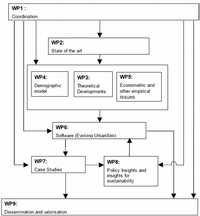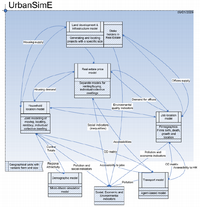Work package 6
Project
components and their interpendencies
Software
(Evolving UrbanSim)
|
|
Leading institution:
|
|
It seems
difficult if not impossible to make an urban simulation model such as UrbanSim
more behaviour-oriented without having a microscopic model of how people (and
ultimately goods) move in the city. In order to leverage existing work,
including computational performance capabilities, we will use existing
behaviour-oriented microscopic traffic models and integrate them with
UrbanSimE. These models will not only provide a microscopic description of the
traffic system, including (ultimately) pedestrian movement, bicycle traffic, and
detailed public transit modelling, but also the behavioural modelling that is
tightly coupled to the traffic system, such as the scheduling of activities in
time and space, task allocation within households, or the consequences of the
selection of certain mobility tools (e.g. car vs. "flat rate" public transport
season ticket). That is, the long-term choices of residence, workplace, and
education will be fed from UrbanSimE to the microscopic transport model, which
will use them to construct daily plans adjusted to those long-term choices. The
performance of those daily plans will then be fed back to UrbanSimE, which will
use these results as a basis for its next round.
|
TUB
|
More
specifically, the objectives are:
- integrate
two existing simulation packages MATSim (behavioural agents) and METROPOLIS
(time-dependent car-traffic) into UrbanSimE:
- design of
travel demand generators from UrbanSimE data targeted toward MATSIM and METROPOLIS;
- design of
feedback accessibility indicators relevant to MATSIM and METROPOLIS including
time-of-day performance of the transportation systems and compatible with micro-economic
theory (logsum's);
- leverage
capability to individually identify travellers both in MATSim and in UrbanSimE
to provide "warm start" capability for runs of the transport model,
dramatically reducing computing times (currently several hours per run of
transport model);
- leverage
microscopic analysis capability inside MATSim to provide better accessibility feedback
to UrbanSimE.
- test
the integration using the case study data


